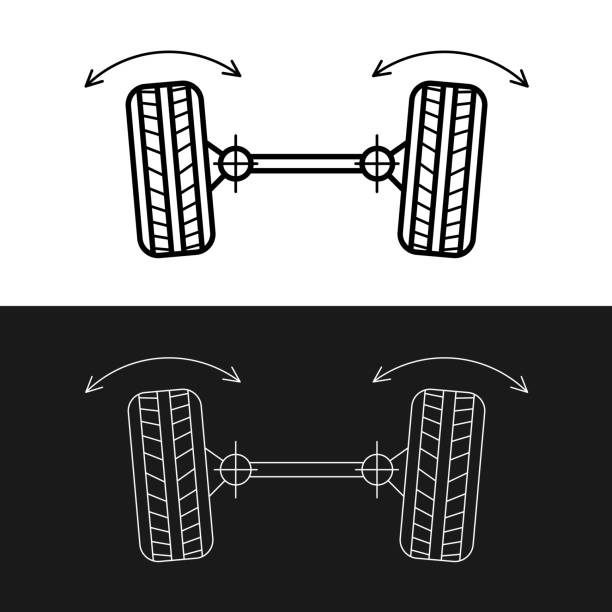

When was the last time you had wheel alignment done on your car?
If you’re driving and notice that you are having trouble with steering and keeping your car straight on the road. Chances are that you probably need to get wheel alignment done on your tyres.
Not to be confused with tyre balancing or wheel balancing (that corrects uneven distribution of weight), wheel alignment is different. It involves a mechanical adjustment of vehicle suspension to influence the direction and angle of the tyre’s contact with the road surface. The optimum alignment for each make and model of vehicle is set by the manufacturer in order to influence the performance and handling. Alignment also impacts upon safety and tyre wear hence, an important element of servicing that should be completed at regular intervals.
It is often recommended that wheel alignment is completed once every two to three years. Depending on how you drive, where you drive and if you meet in any accidents or hit potholes or cur walls, you may need to get your wheels aligned more frequently. Check with trusted car care professionals for guidance.

When a wheel alignment is done, adjustments are made to the vehicle’s suspension to align the angles of the tyres. This affects how they make contact with the road. There are three suspension angles an auto mechanic will inspect and adjust:
Toe: This is the extent to which your tyres turn inward or outward when viewed from above your vehicle. It’s similar to looking at the toes on your feet. They should be perfectly parallel to each other. If turned inward or outward, you need a wheel alignment to correct them.
Camber: This is the inward or outward angle of your tyres when you look at them from the front of your vehicle. Too much tilt inward or outward indicates improper alignment and will need adjustment.
Caster: This is the angle of your steering axis when viewed from the side of your vehicle. This axis should point up and down. If it tilts towards the driver or front of the vehicle, a wheel alignment will angle them properly.

Signs of poor wheel alignment
Now that you know about wheel alignment and tyre angles, here are some signs that your vehicle will require wheel alignment:
- Your vehicle pulls towards the left or right side
- The steering wheel is off centre when driving straight
- Steering wheel vibration
- Abnormal or uneven tread wear
- Positive toe
- Negative toe
- Positive camber
- Negative camber
- Poor caster
Benefits of wheel alignment
Wheel alignment is an extremely important part and can impact overall safety. Aside from the safety and handling aspect, maintaining the correct alignment can also extend the life of your tyres and reduce wear. This will ensure that you get the best value for money from your tyres as well as boosting fuel consumption. Having the correct wheel alignment improves vehicle handling and steering whilst also reducing braking distances compared to misaligned vehicles.

Here’s a breakdown of some of the benefits of wheel alignment:
Vehicle stability
If you notice that your car slightly pulls to one side even when you’re steering straight ahead, your wheel alignment may require adjustment. Having to adjust your steering as a result of bad alignment is tiring, distracting, ineffective and dangerous. Having your wheels aligned properly will mean that your car is easier to drive.

Increases life of your tyres
Tyres, while they can be quite an expensive part, are very important. If regular wheel alignment is neglected, your tyres can wear our much quicker. Tyres that work in harmony with each other will take you a lot further.
Poor alignment causes your new tyres to wear out faster than they should and excessive wear decreases tyre life and costs you money. If you notice your tyres are not wearing evenly, visit a certified auto repair center to have your wheel alignment checked.
Increases gas mileage
Poor alignment causes decreased gas mileage. Cars that need an alignment tend to pull to one side. That action of pulling to the side may cause cars to travel farther than if the tyres traveled straight. Over time, this can add up to several additional miles, especially on long trips. When gas prices go up rapidly, every mile you don’t drive counts.
Improves handling
One of the most important benefits of wheel alignment is improved handling. Properly aligned wheels will make your car handle better on the road, especially when you’re driving at high speeds (please drive within the speed limit).
If your car’s tyres are out of alignment, you will notice that it drifts to one side of the road or the other. This can be extremely dangerous, especially if you’re driving on a busy road.
Additionally, wheel alignment can also improve your car’s braking performance. If your tyres are properly aligned, your car will stop in a straight line rather than veering to one side or the other.

This is the tenth article in the weekly series, ‘Car Care Tips’ where we highlight various aspects of a car, how to provide care and maintenance for optimal performance while ensuring safety. This series may feature your favourite mechanic or others from the motor vehicle industry.
Read the ninth installment of Care Care Tips below:
Car Care Tips | Simple Car A/C Care Tips
Send feedback to [email protected]







Comments